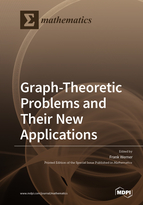Graph-Theoretic Problems and Their New Applications
A special issue of Mathematics (ISSN 2227-7390). This special issue belongs to the section "Mathematics and Computer Science".
Deadline for manuscript submissions: closed (31 January 2020) | Viewed by 64681
Special Issue Editor
Interests: scheduling, in particular development of exact and approximate algorithms; stability investigations is discrete optimization; scheduling with interval processing times; complexity investigations for scheduling problems; train scheduling; graph theory; logistics; supply chains; packing; simulation and applications
Special Issues, Collections and Topics in MDPI journals
Special Issue Information
Dear Colleagues,
Nowadays, graph theory plays a vital role in many disciplines. We invite you to submit your latest original research results in all aspects of graph theory to this Special Issue. We are looking both for new and innovative approaches for traditional graph-theoretic problems and well as for new applications of graph theory in emerging fields, such as in network security, computer science and data analysis, bioinformatics, operations research, engineering and manufacturing, physics and chemistry, linguistics, or social sciences. Both theoretical results, as well as new graph algorithms, with investigations of their computational complexity will be considered. Below, we give an exemplary, but not exhaustive, list of potential subjects for submissions to this Special Issue.
Prof. Dr. Frank Werner
Guest Editor
Manuscript Submission Information
Manuscripts should be submitted online at www.mdpi.com by registering and logging in to this website. Once you are registered, click here to go to the submission form. Manuscripts can be submitted until the deadline. All submissions that pass pre-check are peer-reviewed. Accepted papers will be published continuously in the journal (as soon as accepted) and will be listed together on the special issue website. Research articles, review articles as well as short communications are invited. For planned papers, a title and short abstract (about 100 words) can be sent to the Editorial Office for announcement on this website.
Submitted manuscripts should not have been published previously, nor be under consideration for publication elsewhere (except conference proceedings papers). All manuscripts are thoroughly refereed through a single-blind peer-review process. A guide for authors and other relevant information for submission of manuscripts is available on the Instructions for Authors page. Mathematics is an international peer-reviewed open access semimonthly journal published by MDPI.
Please visit the Instructions for Authors page before submitting a manuscript. The Article Processing Charge (APC) for publication in this open access journal is 2600 CHF (Swiss Francs). Submitted papers should be well formatted and use good English. Authors may use MDPI's English editing service prior to publication or during author revisions.
Keywords
- Deterministic, randomized, exact and approximative graph algorithms
- Paths, cycles, and trees
- Network theory
- Graph labeling
- Graph coloring
- Symmetric graphs
- Polyhedral graphs
- Topological indices
- Domination in graphs
- Applications of graph theory






